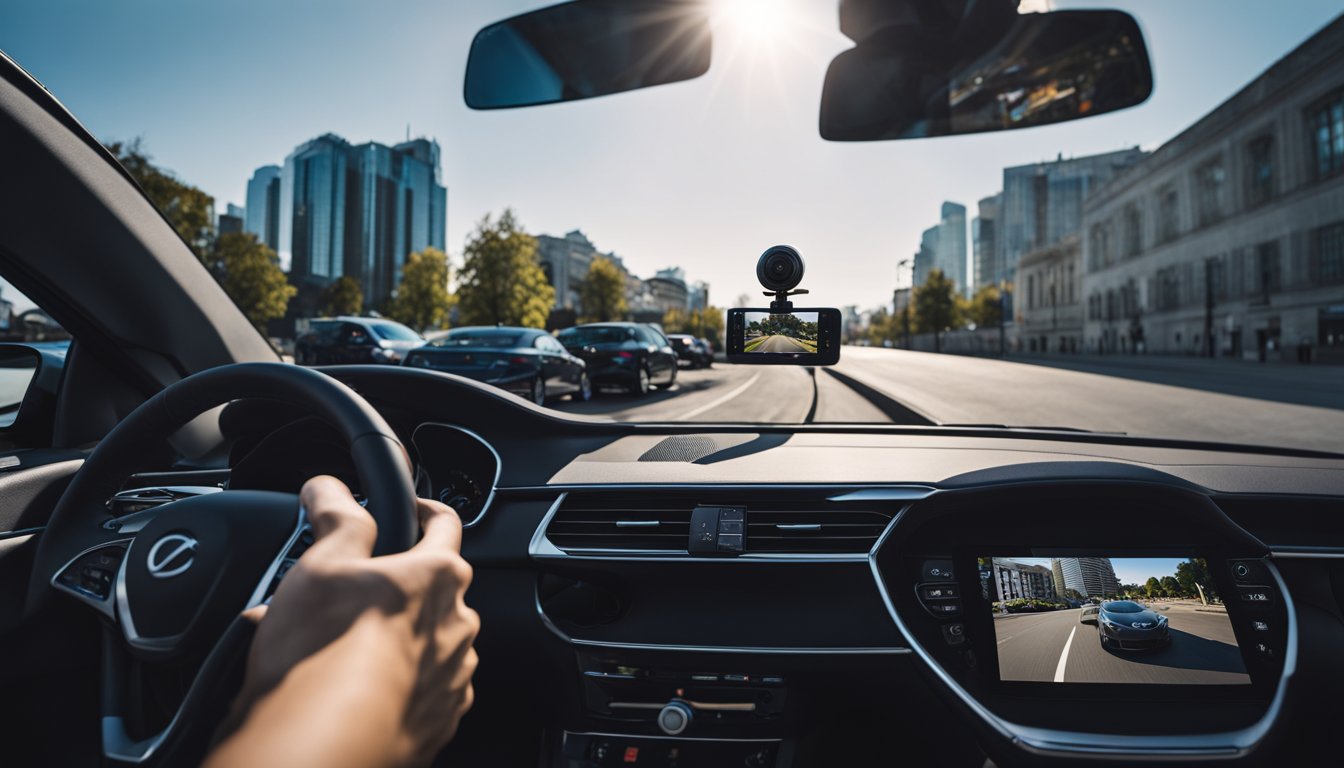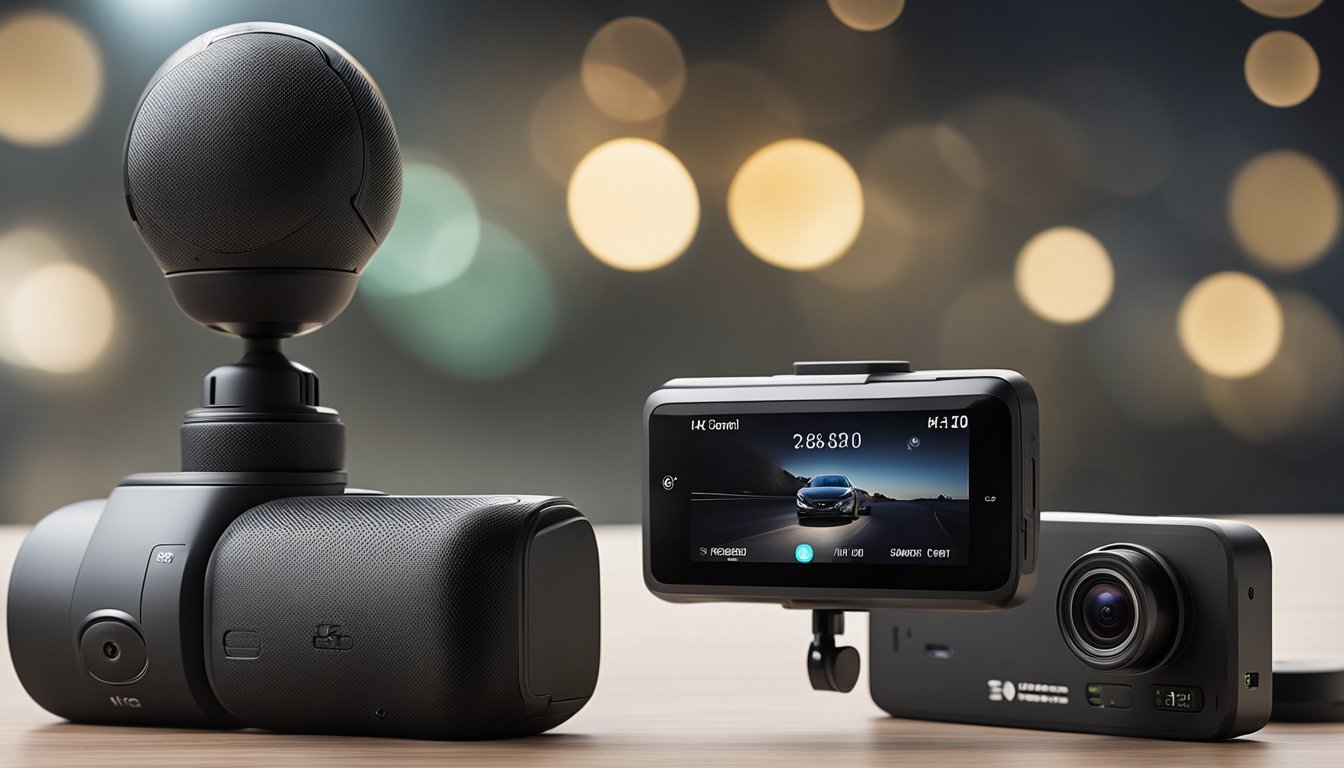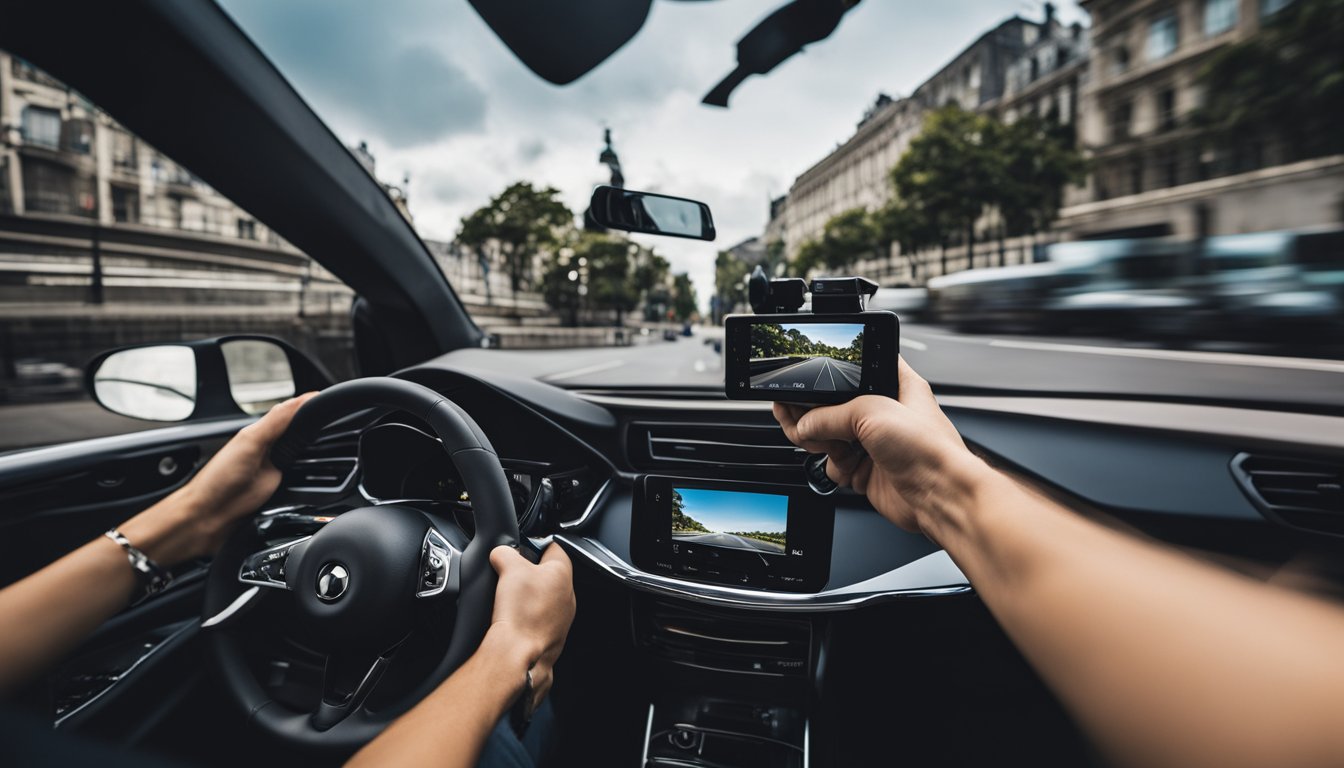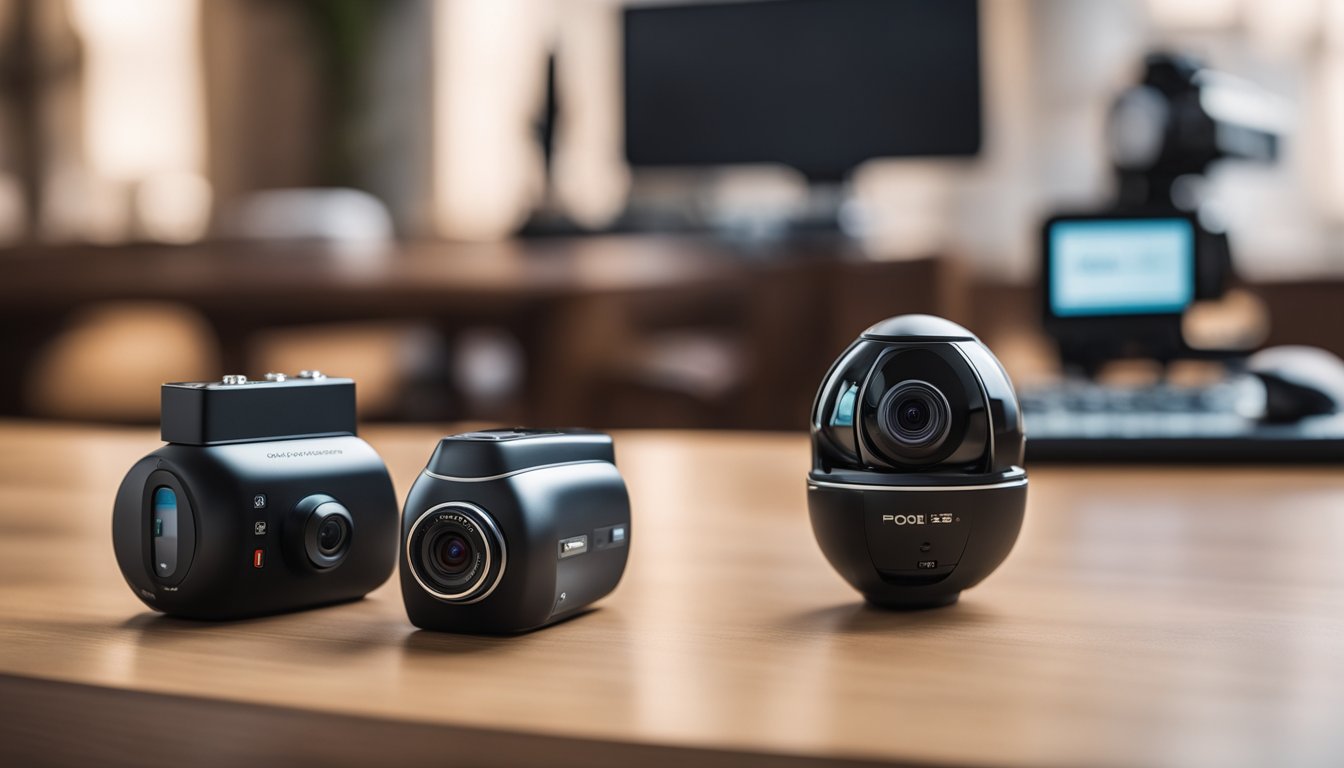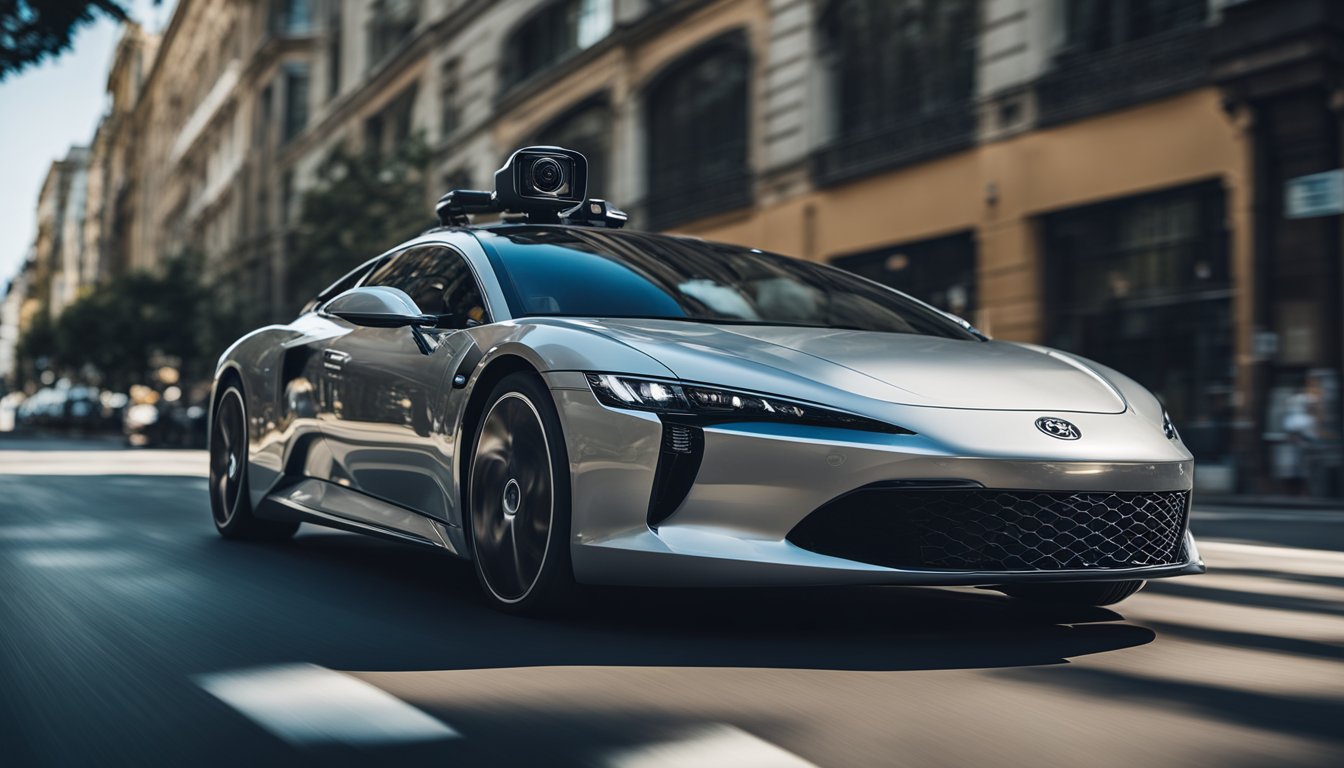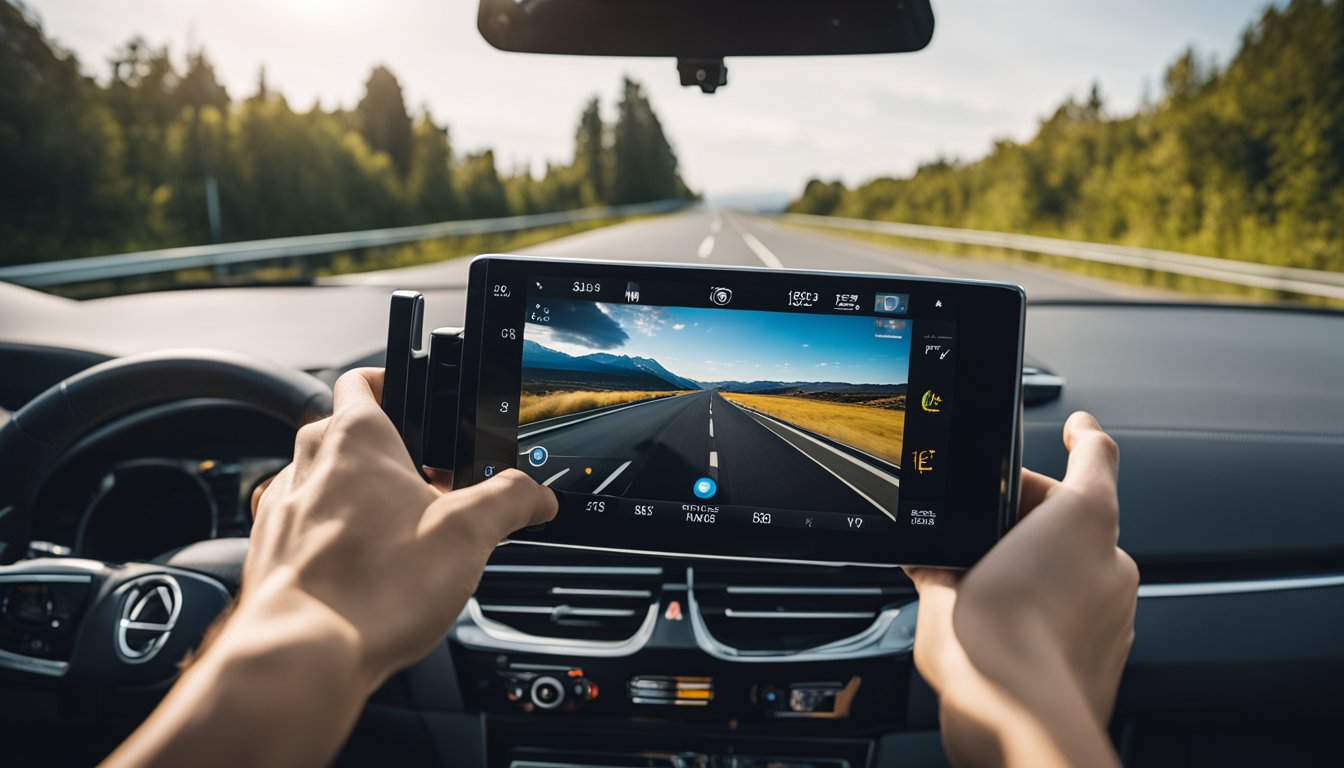If you’re in the market for an in-car camera, you may be wondering whether to go with a 360 camera or a dash cam. Both types of cameras have their benefits, and the right choice for you depends on your specific needs and preferences. In this article, we’ll take a closer look at the differences between 360 cameras and dash cams, so you can make an informed decision.
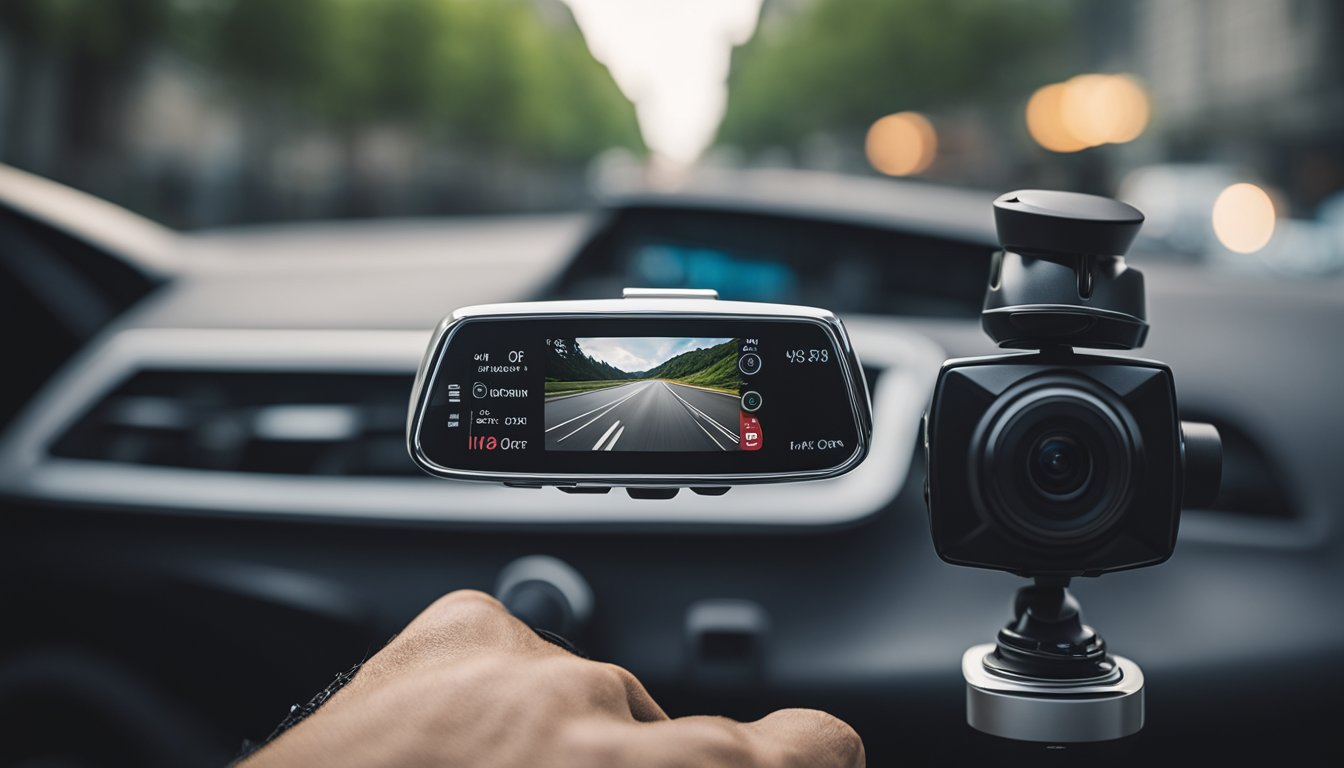
Understanding 360 Cameras and Dash Cams
360 cameras and dash cams are both designed to capture footage of your driving experience, but they do so in different ways. A dash cam is a small camera that is mounted to your windshield or dashboard, and it records the view in front of your car. On the other hand, a 360 camera captures footage in all directions, giving you a complete picture of what’s happening inside and outside your vehicle.
Design and Installation Differences
One of the biggest differences between 360 cameras and dash cams is their design and installation. Dash cams are typically small and compact, and they can be easily mounted to your windshield or dashboard. 360 cameras, on the other hand, are larger and more complex, and they require more installation work. Some 360 cameras are designed to be mounted on the roof of your car, while others can be mounted on your dashboard or windshield.
Key Takeaways
- 360 cameras capture footage in all directions, while dash cams record the view in front of your car.
- Dash cams are small and easy to install, while 360 cameras are larger and more complex.
- 360 cameras offer more advanced features, but they also come with a higher price tag.
Understanding 360 Cameras and Dash Cams
https://www.youtube.com/watch?v=4AnyhHl3_tE&embed=true
If you’re in the market for a camera to help you capture your driving experiences, you may be wondering whether to go for a 360 camera or a dash cam. Both types of cameras have their own unique features and benefits, and the choice ultimately depends on your personal needs and preferences.
Key Features of 360 Cameras
360 cameras are designed to capture a full 360-degree view of your surroundings. They are perfect for capturing panoramic views of the landscape or for recording immersive video footage that allows you to relive your driving experiences in stunning detail. Some of the key features of 360 cameras include:
- Wide-angle lenses that capture a full 360-degree view of your surroundings
- High-resolution sensors that produce clear and detailed images and videos
- Advanced stabilization technology that minimizes camera shake and produces smooth, professional-looking footage
- Built-in Wi-Fi and Bluetooth connectivity that allows you to easily transfer your footage to your smartphone or other devices
Essentials of Dash Cams
Dash cams are designed to capture footage of your driving experiences from the perspective of your car’s windshield. They are perfect for recording accidents, traffic violations, or other incidents that may occur while you’re on the road. Some of the key features of dash cams include:

- Wide-angle lenses that capture a wide field of view from the front of your car
- Loop recording that automatically overwrites old footage to save space on your memory card
- G-sensors that detect sudden impact or movement and automatically save the footage from that time period
- Parking mode that automatically starts recording when it detects motion or impact while your car is parked
In conclusion, both 360 cameras and dash cams have their own unique features and benefits. If you’re looking to capture panoramic views of your surroundings or record immersive video footage of your driving experiences, a 360 camera may be the perfect choice for you. On the other hand, if you’re looking to capture footage of accidents, traffic violations, or other incidents that may occur while you’re on the road, a dash cam may be the better option.
Design and Installation Differences
When it comes to design and installation, there are some key differences between 360 cameras and dash cams. Here are some of the main ones:
Mounting Options
Dash cams are typically mounted on the windshield or rearview mirror using a suction cup or adhesive mount. Some models also come with a magnetic mount that attaches to a metal surface on the dashboard. On the other hand, 360 cameras usually come with a tripod mount or a clip that can attach to a backpack or other object. Some 360 cameras also come with a suction cup mount for attaching to a car’s windshield.
Ease of Installation
Generally speaking, dash cams are easier to install than 360 cameras. They are designed to be mounted quickly and easily on the windshield or rearview mirror without requiring any special tools or skills. Most dash cams also come with detailed instructions and video tutorials that make the installation process even easier.
« How Does a 360 Security Camera Work: A Simple Explanation
Cheap Camera 360 Free: How to Get a High-Quality 360 Camera for Free »
360 cameras, on the other hand, can be a bit more difficult to install. They require more setup time and may require additional tools such as a tripod or a mounting bracket. Additionally, because they are designed to capture a full 360-degree view, they may require more careful placement and calibration to ensure that they are capturing the desired footage.
Overall, while both 360 cameras and dash cams have their own unique advantages and disadvantages when it comes to design and installation, dash cams are generally easier to install and use. However, if you are looking for a more versatile camera that can capture a full 360-degree view, a 360 camera may be the better choice for you.
Video Quality and Field of View
https://www.youtube.com/watch?v=lzdxCOvPq5Q&embed=true
When it comes to video quality, both 360 cameras and dash cams offer high-resolution options. Dash cams generally record in 1080p, while 360 cameras can record in 4K or even higher. The higher the resolution, the sharper and more detailed the video will be. However, it’s important to note that higher resolution videos take up more storage space.
Resolution and Clarity
If you’re looking for a dash cam with excellent video quality, the Vantrue N4 is a great option. According to Wirecutter, it delivers the sharpest video they’ve seen. It also has HDR technology, which helps to balance the exposure in bright and dark areas of the video.
On the other hand, if you’re interested in a 360 camera with high-resolution video, the GoPro MAX is a good choice. It can record in 5.6K, which is an incredibly high resolution. It also has HDR technology and can shoot in 360 degrees, giving you a complete view of your surroundings.
Viewing Angles Comparison
One of the main differences between 360 cameras and dash cams is the field of view. Dash cams typically have a wide field of view, ranging from 120 to 170 degrees. This allows them to capture a large portion of the road in front of you.
360 cameras, on the other hand, have an even wider field of view. They can capture everything around you, including what’s behind you and to the sides. This makes them a great option for capturing scenic drives or for use in a car that has a lot of blind spots.
Overall, both 360 cameras and dash cams offer high-quality video and wide fields of view. The choice between the two will depend on your specific needs and preferences.
Smart Features and Connectivity
When it comes to smart features and connectivity, 360 cameras and dash cams differ quite a bit. Let’s take a closer look at how they compare in terms of GPS and tracking, as well as smartphone integration.
GPS and Tracking
Many dash cams come equipped with GPS technology, which can help you track your location and speed. This can be especially useful if you’re involved in an accident and need to provide evidence of what happened. Some dash cams even allow you to view your route on a map, which can be helpful if you’re traveling in unfamiliar territory.
On the other hand, 360 cameras typically don’t come with built-in GPS. However, some models do offer the ability to connect to your smartphone’s GPS, which can provide location data for your footage.
Smartphone Integration
Both 360 cameras and dash cams can be connected to your smartphone for easy access to footage and settings. However, the level of integration can vary between models.
Many dash cams come with a dedicated smartphone app that allows you to view footage, adjust settings, and even download clips to your phone. Some models even offer cloud connectivity, which allows you to store footage online and access it from anywhere.
360 cameras also typically come with a smartphone app that allows you to view and edit your footage. However, some models offer more advanced features, such as AI-powered editing tools and the ability to stream footage live to social media platforms.
Overall, both 360 cameras and dash cams offer a range of smart features and connectivity options. However, the specific features available can vary widely between models, so it’s important to do your research and choose a camera that meets your specific needs.
Storage and Memory Options
https://www.youtube.com/watch?v=3QAF2flNsVc&embed=true
When it comes to storage and memory options, both 360 cameras and dash cams have their own advantages and disadvantages. In this section, we will discuss the two most common options: SD card and cloud storage.
SD Card vs. Cloud Storage
SD card storage is the most common option for both 360 cameras and dash cams. It is easy to use, affordable, and provides a convenient way to store footage. Most cameras come with a removable SD card that overwrites the oldest footage as the card fills. To retrieve the desired footage, you simply need to remove the SD card from the device and download the footage manually on your computer.
On the other hand, cloud storage is a newer and more advanced option for storing footage. Some cameras record wirelessly and automatically upload the footage to cloud storage. The benefit of cloud storage is that it provides a more secure option for storing footage, as well as the ability to access footage remotely from anywhere with an internet connection. However, this option may come with a subscription fee, and the quality of the footage may depend on the internet speed.
When choosing between SD card and cloud storage, it ultimately comes down to personal preference and needs. If you prefer a more traditional and affordable option, SD card storage may be the best choice for you. If you want a more advanced and secure option, cloud storage may be the way to go.
Overall, both options have their own advantages and disadvantages, and it is important to consider your own needs and preferences when making a decision.
Safety and Security Features
https://www.youtube.com/watch?v=bC4K-rp_fh4&embed=true
When it comes to choosing between a 360 camera and a dash cam, safety and security features should be a top priority. Here are some of the features you should consider:
Collision Detection Systems
Both 360 cameras and dash cams can have collision detection systems that can help you avoid accidents or provide evidence in case of a collision. These systems use a G-sensor to detect sudden changes in speed or direction and can automatically save footage before, during, and after a collision. Some dash cams even have lane departure warnings and forward collision warnings to alert you if you’re driving too close to another vehicle or if you’re drifting out of your lane.
Parking Mode and Motion Detection
If you’re concerned about the safety of your vehicle while it’s parked, you may want to consider a dash cam with parking mode and motion detection. Parking mode allows the dash cam to continue recording even when the engine is turned off, and motion detection can trigger the dash cam to start recording if it detects any movement around your vehicle. Some dash cams even have a time-lapse feature that can show you what happened around your vehicle over a certain period of time.
While 360 cameras may not have parking mode or motion detection, they can still provide valuable footage in case of a collision or other incident. With a 360 camera, you can capture a full 360-degree view of your surroundings, which can help you identify the cause of a collision or provide evidence in case of a hit-and-run.
Overall, both 360 cameras and dash cams can provide valuable safety and security features for your vehicle. It’s important to choose the right device based on your specific needs and preferences.
User Experience and Control
When it comes to user experience and control, there are a few key differences between 360 cameras and dash cams. Let’s take a look at some of the main factors that can impact your experience using these devices.
Touchscreen Interfaces
Many 360 cameras and dash cams come equipped with touchscreen displays that allow you to easily control the device and access features. These displays can vary in size and quality, so it’s important to consider your preferences and needs when choosing a device.
If you prefer a larger display with high resolution, you may want to opt for a 360 camera with a larger touchscreen. However, if you’re more concerned with portability and ease of use, a smaller dash cam with a smaller touchscreen may be a better choice.
Voice Commands and Control
Voice commands and control are becoming increasingly popular in both 360 cameras and dash cams. With voice control, you can easily access features and control the device without having to physically interact with it.
Some 360 cameras and dash cams come equipped with built-in voice assistants like Amazon Alexa or Google Assistant, which can provide additional functionality beyond just controlling the camera. However, keep in mind that voice control may not always be reliable in noisy or windy environments.
Overall, both 360 cameras and dash cams offer unique user experiences and control options. Consider your needs and preferences when choosing a device to ensure that you get the most out of your investment.
Cost Considerations
When it comes to cost considerations, both 360 cameras and dash cams come in a range of prices to fit any budget. Here are some things to keep in mind when considering cost.
Budget-Friendly Options
If you’re looking for a budget-friendly option, there are plenty of affordable dash cams and 360 cameras available. Dash cams with basic features can be found for as little as $30-50, while budget 360 cameras can be found for around $100-150. These types of cameras usually don’t have advanced features like night vision or motion detection, but they do provide solid recording capabilities so you can capture footage while you’re on the road.
Investing in High-End Models
If you’re willing to invest in a high-end model, both 360 cameras and dash cams can offer advanced features like 4K resolution, built-in GPS, and advanced driver assistance systems (ADAS). High-end dash cams can cost anywhere from $100-300, while high-end 360 cameras can cost upwards of $500-600. While these models can be more expensive, they often come with better build quality and more advanced features, making them a great investment for those who want the best possible recording quality.
When deciding between a 360 camera and a dash cam, cost is definitely a factor to consider. While budget-friendly options are available for both types of cameras, investing in a high-end model can provide better recording quality and more advanced features. Ultimately, the decision comes down to your personal budget and needs.
The Top Models on the Market
https://www.youtube.com/watch?v=n3KyXcddXV8&embed=true
If you are in the market for a dash cam or 360 camera, there are a lot of options to choose from. To help you make an informed decision, we have compiled a list of the top models currently available.
Best Overall Picks
When it comes to the best overall dash cams on the market, the Nextbase 622 and the Garmin Dash Cam Mini 2 are two of the top picks. The Nextbase 622 offers a 4K resolution and a 140-degree viewing angle, making it one of the most advanced dash cams available. The Garmin Dash Cam Mini 2, on the other hand, is incredibly small and discreet, making it perfect for those who want to keep their dash cam hidden.
If you are looking for a 360 camera, the Ring Car Cam and the Nextbase 622GW are two of the best options available. The Ring Car Cam offers a 1080p resolution and a 140-degree viewing angle, while the Nextbase 622GW boasts a 4K resolution and a 360-degree field of view.
360 Camera vs. Dash Cam Specific Models
If you are specifically looking for a dash cam, the Garmin Dash Cam Tandem and the Rexing V1 are two models worth considering. The Garmin Dash Cam Tandem offers a front and rear-facing camera, as well as a 1440p resolution. The Rexing V1, on the other hand, is a more budget-friendly option that still offers a 1080p resolution and a wide-angle lens.
If you are specifically looking for a 360 camera, the Garmin Dash Cam Live and the Cobra SC 400D are two models worth considering. The Garmin Dash Cam Live offers a 1440p resolution and a 180-degree field of view, while the Cobra SC 400D offers a 1080p resolution and a 360-degree field of view.
No matter what type of camera you are looking for, there are plenty of great options available on the market. Consider your specific needs and budget when making your decision, and don’t be afraid to do your research to find the perfect camera for you.
Additional Considerations for Drivers
When it comes to choosing between a 360 camera and a dash cam, there are a few additional considerations that you should keep in mind. Here are some things to think about before making your decision.
Insurance and Legal Aspects
One of the most significant benefits of having a dash cam or 360 camera is that it can provide valuable evidence in case of an accident. This can be especially helpful when dealing with insurance companies or legal proceedings. Some insurance companies may even offer discounts for drivers who have a dash cam installed.
However, it’s important to note that the laws surrounding dash cams and 360 cameras vary by state and country. Before installing one, make sure you are familiar with the regulations in your area. Additionally, if you are planning to use footage as evidence in court, it’s important to ensure that the camera meets certain legal requirements.
Choosing for Professional Use
If you are a professional driver, such as an Uber or Lyft driver, you may want to consider installing multiple cameras. A rear dash cam can be particularly useful in this situation, as it can capture footage of any incidents that occur behind your vehicle. This can provide an additional layer of protection and help to ensure your safety and the safety of your passengers.
Additionally, if you are using a dash cam or 360 camera for professional purposes, you may want to consider investing in a higher-end model. These cameras often have additional features, such as GPS tracking and cloud storage, that can be helpful in a professional setting.
Overall, when choosing between a 360 camera and a dash cam, it’s important to consider your individual needs and priorities. By taking the time to research and weigh your options, you can make an informed decision that will help to ensure your safety and peace of mind while on the road.
Future of In-Car Cameras
https://www.youtube.com/watch?v=g9OQFw5C8oA&embed=true
In-car cameras have come a long way in recent years, and they’re only going to get better. As technology continues to evolve, we can expect to see more advanced cameras and features in both dash cams and 360 cameras. Here are some emerging technologies to keep an eye on:
Emerging Technologies in Dash Cams
Dash cams are becoming more advanced and feature-packed. One of the most exciting developments is the integration of forward-collision warnings. These systems use sensors to detect when you’re getting too close to the car in front of you and will alert you if you need to brake. Some dash cams also have lane departure warnings, which can help prevent accidents caused by drifting out of your lane.
In addition to these safety features, some dash cams are also becoming more like full-fledged electronics devices. For example, some models have built-in Wi-Fi, which allows you to easily transfer footage to your phone or computer. Others have touchscreens, which make it easier to navigate menus and adjust settings.
The Evolution of 360 Cameras
360 cameras are also evolving rapidly. One of the most exciting developments in this area is the addition of rear-facing cameras. This allows you to see what’s going on behind you, which can be especially helpful when backing up or changing lanes on the highway.
Another exciting development is the integration of accessories. For example, some 360 cameras can be mounted on a drone or other device, allowing you to capture footage from unique angles. Additionally, some cameras have built-in stabilization, which can help smooth out footage and reduce shakiness.
Overall, the future of in-car cameras looks bright. As technology continues to improve, we can expect to see more advanced features and capabilities. Whether you’re looking for a dash cam or a 360 camera, there’s never been a better time to invest in this technology.
Frequently Asked Questions
What are the benefits of using a 360 camera in a car compared to a traditional dash cam?
A 360-degree camera provides a complete view of the vehicle’s surroundings, which can help with parking, reversing, and avoiding collisions. It can also capture footage of incidents that occur outside of the vehicle, such as hit-and-runs. Additionally, 360 cameras can provide a more immersive and detailed view of road trips and scenic drives.
Can a 360 camera provide full coverage around my vehicle for insurance purposes?
Yes, a 360 camera can provide full coverage around your vehicle, which can be useful for insurance purposes. However, it is important to check with your insurance provider to ensure that a 360 camera system meets their requirements for coverage.
How does a 360-degree camera installation differ from setting up a standard dash cam?
The installation process for a 360-degree camera system can be more complex than setting up a standard dash cam. A 360 camera typically requires multiple cameras to be mounted in different locations around the vehicle, and the footage from each camera must be stitched together to create a seamless 360-degree view. This can require more time and effort than a standard dash cam installation.
What are the potential drawbacks of using a 360-degree camera system in a vehicle?
One potential drawback of using a 360-degree camera system is the cost. 360 cameras can be more expensive than traditional dash cams, and the installation process can also be more expensive. Additionally, 360 cameras may require more storage space for footage, which can be a concern for drivers with limited storage capacity.
Are there any specific advantages of the Garmin 360-degree dash cam over other models?
The Garmin 360-degree dash cam offers several advantages over other models. It has a high-resolution display that provides a clear view of footage, and it includes advanced safety features such as collision warnings and lane departure alerts. Additionally, the Garmin 360-degree dash cam is designed to be easy to use and install.
How do features of 360 dash cams compare to front and rear dash cam systems?
Front and rear dash cam systems are designed to capture footage from the front and rear of the vehicle, while 360-degree cameras provide a complete view of the vehicle’s surroundings. 360 cameras can be more expensive and require more storage space, but they offer a more comprehensive view of the road and can be useful for parking, reversing, and avoiding collisions.

